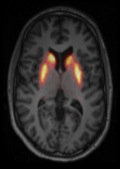Assessment of the Dopaminergic System In Vivo Using 18F Fallypride PET
Dopamine plays an important role in regulating several aspects of basic brain function and is involved in the development of several psychiatric and neurological disorders including Parkinson’s disease, Schizophrenia, Addiction and Attention Deficit Hyperactivity Disorder. Positron Emission Tomography (PET) is a technique where pharmaceuticals are tagged with radioactive markers. These radioactive markers emit antimatter in the form of positrons which then interact with nearby electrons to generate a signal which can be used to map the distribution of the molecule within the patient. Therefore, with PET, it is possible to measure the distribution of molecules in the brain in order to be able to measure many aspects of brain function, including the dopaminergic system.
The Wales Research and Diagnostic PET Imaging Centre (PETIC) has the ability to image pre synaptic Dopamine transport and transmission within the brain, using the radioactive pharmaceutical 18F DOPA, and is already using this technique to assess whether new treatments in Parkinson’s disease increase Dopamine production within the brain.
With support from the Life Science Research Network Wales, PETIC will build on this success by offering post synaptic assessment of D2 and D3 receptors using 18F Fallypride PET to complement the pre synaptic assessment. This will enable PETIC to assess the functional response of the Dopaminergic system in vivo to facilitate drug development in the fields of Parkinson’s disease, Schizophrenia, Addiction and Attention Deficit Hyperactivity Disorder.
For further details please contact Dr Chris Marshall, Director of PETIC at Cardiff University on (029) 20748164 (marshallc3@cf.ac.uk).



